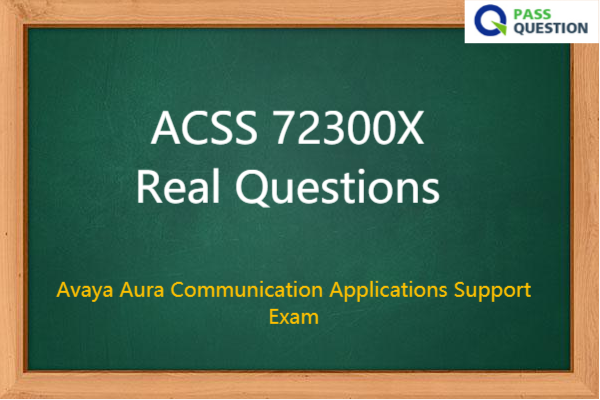ACSS 72300X Real Questions - Avaya Aura Communication Applications Support Exam
72300X Avaya Aura Communication Applications Support Exam is a hot ACSS Certification test. You can pass this 72300X Exam with confidence covering all Avaya 72300X Exam Objectives with the help of PassQuestion ACSS 72300X Real Questions, PassQuestion ACSS 72300X Real Questions are the most authentic and reliable source of information to help you prepare for the Avaya 72300X exam in a timely manner. After you master all the topics, and learn of 72300X Q&A, you will surely have a thorough understanding of 72300X knowledge. Our ACSS 72300X Real Questions are surely the best choice for you to pass Avaya 72300X exam with high scores.

72300X Avaya Aura Communication Applications Support Exam
The Avaya Aura Communication Applications Support Exam (72300X) is a requirement to earn the ACSS - Avaya Aura Communication Applications credential. This exam has 66 questions and the minimum passing score is 67% (44 of 66 correct). The candidate has 90 minutes to complete this exam.
Exam Topics
Communication Applications Architecture
Describe the purpose, the features, and configuration of Avaya Breeze? and Avaya Presence Services for the operation of Avaya Breeze? and APS configuration.
Describe the purpose, the features, and configuration of ASBCE/SIP trunking and Remote Workers.
Describe the purpose, the features, and configuration of AAM.
Describe the purpose, the features, and configuration of Avaya Web-RTC snap-in on Breeze.
Describe the purpose, the features, and configuration of AES for the operation of a TSAPI link between AES and CM.
Troubleshooting Methodology
Demonstrate how to use Avaya Breeze?-specific and Avaya Presence Services-specific troubleshooting tools and techniques.
Demonstrate how to use ASBCE-specific troubleshooting tools and techniques.
Identify the existing Avaya GSS Methodology which integrates the 8D Methodology.
Differentiate between which levels of support use which steps of the 8D Methodology.
Demonstrate how to use AES-specific troubleshooting tools and techniques.
Demonstrate how to use AAM-specific troubleshooting tools and techniques.
Identify the Avaya Communication Applications call flows.
Message and Call Flows
Troubleshoot Avaya Communication Applications faults.
View Online Avaya Aura Communication Applications Support 72300X Free Questions
1.To validate the initial system status of Breeze with the WebRTC Snap-I, which two components should be checked? (Choose two.)
A. application
B. configured certificates
C. cluster status
D. licensing status
E. installation status
Answer: A,E
2.A technician is trying to access the Avaya Aura ? Media Server (AAMS) after receiving a troubleshooting ticket. After failing to enter the system using different web browsers, the technician realizes the incorrect URL was being used.
Which URL must be used to access the AAMS web page?
A. https: AAMS FQDN or IP address:8443/emlogin
B. http: AAMS FQDN or IP address:8443/emlogin
C. https: AAMS FQDN or IP address:443/emlogin
D. https: SMGR FQDN or IP address:8443/emlogin
Answer: A
3.A customer reports that Instant Messaging (IM) and Presence are not working for one or two users.
Where would you go to check that IM and Presence have been enabled for the affected users?
A. Use Avaya Aura? System Manager (SMGR) web GUI to access the Engagement Development Platform > Service Management click on List Presence Users.
B. Use System Manager (SMGR) web GUI to access User > Users Management > Manage Users > Communication Profile. Ensure that the presence profile is enables and that the right presence server is selected.
C. Use SSH to Avaya Breeze ?and run “display user xxxx” where xxxx is the station number.
D. Use Avaya Aura? System Manager (SMGR) web GUI to access User Management > Manage Users > More Actions > Presence Users. Ensure that the presence profile is enables and that the right presence server is selected.
Answer: B
4.When a user is forwarded to Avaya Aura? Messaging (AAM), Avaya Aura? Communication Manager (CM) needs to indicate to AAM who the call was originally destined for, so that the message is left in the correct mailbox.
Which SIP header is used to indicate for whom the call was originally destined, and the reason for being forwarded to AAM?
A. B = history info
B. To
C. Request
D. P-Asserted-Identity
Answer: C
5.Which statement about Network Routing Policies in Avaya Aura? Session Manager (SM) is true?
A. A dial pattern and routing policy are necessary in SM to call from an H323 device to a Basic/Native SIP device (without an Avaya Aura? Communication Manager profile).
B. A dial pattern and routing policy are necessary in SM to call from a Basic/Native SIP device (without a CM profile) to an H323 device on Avaya Aura? Communication Manager (CM).
C. A dial pattern and routing policy are necessary in SM to call from an H323 device to an AST device on the same Avaya Aura? Communication Manager (CM).
D. A dial pattern and routing policy are necessary in SM to call from an AST device to an H323 device on the same Avaya Aura? Communication Manager (CM).
Answer: A
- TOP 50 Exam Questions
-
Exam
All copyrights reserved 2025 PassQuestion NETWORK CO.,LIMITED. All Rights Reserved.

